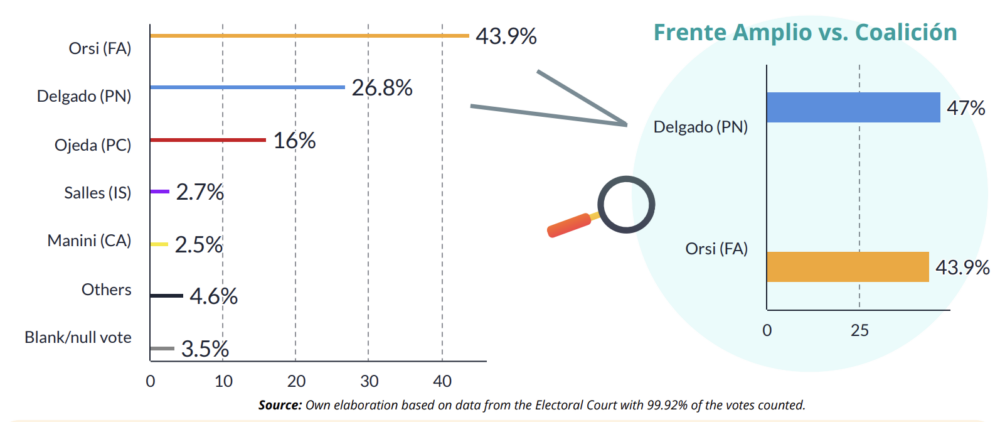General elections in Uruguay: Orsi wins the first round and will face Delgado in the runoff

With 99.92% of the votes counted, Frente Amplio candidate Yamandú Orsi finished first with 43.9%. As he did not reach 50%, a runoff will be held against Álvaro Delgado from the ruling Partido Nacional, who secured 26.8%.
Andrés Ojeda from Partido Colorado along with the candidates from Cabildo Abierto and Partido Independiente—all part of the current Multicolor Coalition—have confirmed their support for Delgado in both the runoff and a potential government. The new Congress features a Frente Amplio majority in the Senate and a balanced scenario in the Chamber of Deputies. Finally, both Sunday plebiscites—one on the pension system and another on nighttime raids—were rejected by voters. The runoff is scheduled for November 24.
Voter turnout was high, reaching 89% by the end of the day, with no major incidents reported. Delgado and his Multicolor Coalition partners celebrated their status as the most voted bloc, securing a combined total of 47% of the votes. Meanwhile, Orsi highlighted the growth of the Frente Amplio since 2019 and pledged to maintain momentum heading into the runoff. The winner of the November runoff will assume office on March 1, 2025.
Presidential election results
Orsi was the most voted candidate, as anticipated by the polls, but he failed to win the presidency outright. Delgado, meanwhile, exceeded expectations by reaching nearly 27%. Once the results were announced, the Coalición Multicolor called for unity and confirmed the alliance between the Partido Nacional, Partido Colorado, Cabildo Abierto and the Partido Independiente, both for the runoff and for a potential government.

Both campaigns will face challenges leading up to November 24. Delgado will need to consolidate support from voters of the other coalition parties and gain additional support from undecided voters. Orsi, for his part, will have to expand his base by appealing to smaller parties (which collectively obtained 4.5% of the votes). Since 89% of eligible voters participated, increasing voter turnout as a strategy to reach the majority does not appear viable.
How does Congress shape up?
Frente Amplio is expected to achieve a majority in the Senate with 16 seats. The Multicolor Coalition, as a whole, would obtain 14 seats: 9 from Partido Nacional and 5 from Partido Colorado. This outcome would bring two key developments: a leftist majority and the “disappearance” of Cabildo Abierto, dropping from 3 senators to none.
In the Chamber of Deputies, no party would achieve an outright majority. Frente Amplio would hold 48 seats, while the Multicolor Coalition would reach 49 (29 from Partido Nacional, 17 from Partido Colorado, 2 from Cabildo Abierto, and 1 from Partido Independiente). Meanwhile, the new anti-establishment party, Identidad Soberana, would secure two seats.

The final and official composition of Congress will be determined by the definitive vote count. Regardless, the incoming president will need to build consensus in the parliament, although Orsi would have a slight advantage in this regard. The new Congress will start its term on February 15, 2025.
